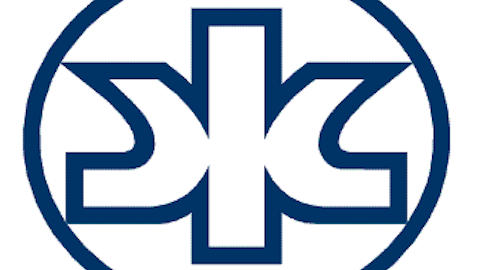When companies are about to report earnings, investors would do well to look at the prior earnings report to try and find trends that may continue over the next few quarters. With Colgate-Palmolive Company (NYSE:CL)’s earnings report right around the corner, there are four trends that shareholders should hope will continue.

Growth and Income on a Global Scale
There are two things that define Colgate-Palmolive Company (NYSE:CL)’s current market position. First, the company competes against some of the most well-known companies in the world. Colgate competes against titans such as The Procter & Gamble Company (NYSE:PG), The Clorox Co (NYSE:CLX), and Kimberly Clark Corp (NYSE:KMB). Each of these companies generates billions in sales all over the world, and has some of the most well-known brands in history.
In addition, each of these companies offers investors similar yields and earnings growth rates. One reason investors might choose to overlook Colgate-Palmolive Company (NYSE:CL) is their relatively lower yield at about 2.3%. Since investors can get a 3% yield from The Procter & Gamble Company (NYSE:PG), and about 3.3% from both The Clorox Co (NYSE:CLX) and Kimberly Clark Corp (NYSE:KMB), Colgate’s yield might not look competitive.
That being said, Colgate-Palmolive Company (NYSE:CL) leads their peers when it comes to expected earnings growth. In the next few years, analysts expect earnings growth of over 9%, whereas all of its peers is expected to grow earnings by less than 8%. Relatively speaking, Colgate-Palmolive Company (NYSE:CL)’s faster expected earnings growth helps to offset the company’s slightly lower yield.
Sales Growth and Signs of Stability
When comparing multi-billion dollar companies, one of the best ways to determine which one has the strongest sales momentum is by looking for strong volume growth. While it’s hard to compare Colgate-Palmolive Company (NYSE:CL) to its peers because they each report sales differently, it’s fairly clear that the company has volume growth on its side.
In the company’s last earnings report, Colgate-Palmolive said that unit volume was up 3.5% in North America, 5.5% in Latin America, and 11% in the Greater Asia/Africa region. The only region to show flat volume growth was Europe, which isn’t surprising considering the weakness in the region. By comparison, The Procter & Gamble Company (NYSE:PG) reported volume growth in three of its five divisions, and Kimberly Clark Corp (NYSE:KMB) reported volumes up 3% and 4% in its two largest divisions; The Clorox Co (NYSE:CLX) fell behind with mostly 1% volume increases. This leads us to the first thing investors should look for in Colgate-Palmolive’s upcoming earnings report: continued strength in organic volume growth across the company’s geographic divisions.
In connection with potentially strong volume growth, investors should keep an eye out for signs of stability in the company’s European operations. While most of its competition saw negative volume growth in Europe, Colgate-Palmolive was able to maintain its volume last quarter. Given that European operations have been a drag on the company’s performance, any signs of increased volume in the region would be a huge positive for the stock.
Keep on Keeping on
Sometimes the best way investors can gauge a company’s strength is just by looking for continued strength in a few key areas. Companies don’t always have to improve their performance as much as maintain impressive performance to be a good long-term investment.
In Colgate-Palmolive’s case, the company’s gross margin leads their peer group by a comfortable amount. In the last quarter, the company’s gross margin was 58.6%. This number was impressive considering that Colgate-Palmolive’s gross margin last quarter was 58.3%, and last year this number stood at 58%. While it would be nice to see the company continue to grow its gross margin, given the lead over its peers I think investors should be more than happy if the company can continue this dominance.
When you consider that their peer with the second-best gross margin is The Procter & Gamble Company (NYSE:PG) at 49.8%, and that The Clorox Co (NYSE:CLX)’s margin is just over 42%, you can see what a large lead Colgate-Palmolive enjoys. Unfortunately for Kimberly Clark Corp (NYSE:KMB) investors, the company’s strong volume growth is being somewhat muted by the company’s relatively low gross margin of 34.26%.
A final way investors can look for continued strength from Colgate-Palmolive is in the company’s ability to continue increasing prices to offset cost inflation. Generally speaking, companies that can increase prices and still grow volumes should be favored over companies that see flat or declining volumes with increased prices. Given that Colgate-Palmolive was able to increase prices 2% in North America and 3% in Latin America in the last quarter, investors should look for continued pricing strength in these two areas.
In fact, I would argue that Colgate-Palmolive’s pricing strength and volume growth combination is what sets the company apart from their competition. Investors in Colgate-Palmolive have a lot to look forward to in the upcoming weeks. If the company can continue producing volume and pricing gains, combined with strong margins, the stock should do fine.
Any improvement in the company’s European operations would be a big positive and could give a lift to the stock. After a decent run over the last several months, if Colgate-Palmolive can stick with its strengths, long-term investors should be more than happy with the results.
Chad Henage owns shares of Colgate-Palmolive. The Motley Fool recommends Kimberly-Clark and Procter & Gamble. Chad is a member of The Motley Fool Blog Network — entries represent the personal opinion of the blogger and are not formally edited.
The article A Bright Outlook Based on These 4 Measures originally appeared on Fool.com is written by Chad Henage.
Copyright © 1995 – 2013 The Motley Fool, LLC. All rights reserved. The Motley Fool has a disclosure policy.




